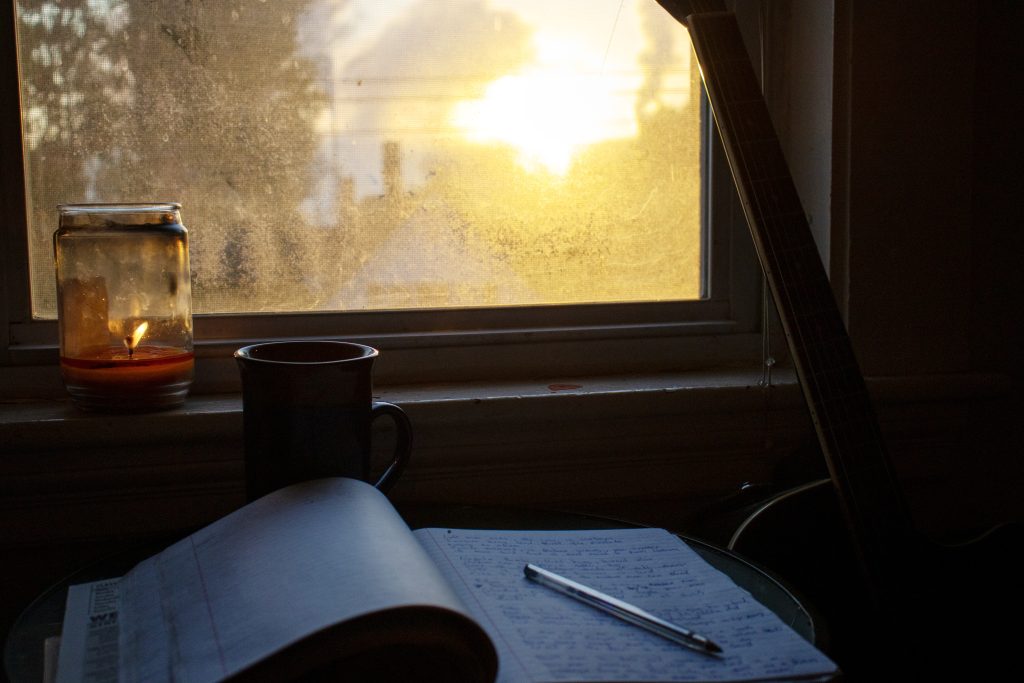What Is Anthropological Poetry?

“For me, poetry is the music of being human.”
—Carol Ann Duffy
Scribbling in your field journal, you can feel the sentence snap in two like a branch stepped on—the meaning broken by the grammatical demands of prose. You suddenly find your pen working down the page in a rhythmic fashion, the writing at once spacious, languid, and succinct.
Without explanation, you allow a different mode of consciousness as you craft something new: metaphors emerge, images are enlivened, hidden emotions and tensions surface, deeper layers of meaning and human interaction are revealed.
You find yourself inside an anthropological poem. What now? How can you shape this work into a poem the broader public will want to read?
SAPIENS’ poet-anthropologists and others over the past century have been showing us how. To highlight a few tips and reflections, we share our thoughts on anthropological poetry. As the poetry editor at the magazine, I (Christine) review poetry submissions against the backdrop of historical and contemporary conversations about what “anthro-poetry” is and what it can be. The poems selected for SAPIENS must in some way illuminate anthropology for a broad readership, but they may also push edges in both fields by traveling freshly strung gossamer threads between poetic craft and research-based content and insights.
As the inaugural poet-in-residence at the magazine in 2021, I (Justin) had time, space, and encouragement to develop my thoughts on a Black ethnographic poetics. I was able to explore what poetry can do, its power, and the myriad ways it helps us live more fully, more joyously.
POET-ANTHROPOLOGISTS ENGAGE THE WORLD
Anthropologists “study all aspects of human existence, past and present,” writes Danilyn Rutherford, the president of the Wenner-Gren Foundation, which funds SAPIENS. From archaeologists to linguistic anthropologists, to biological anthropologists, paleoanthropologists, and sociocultural anthropologists, researchers “document the meanings humans make of the different worlds they inhabit.”
So, it’s not a surprising hop from studying human existence to writing poetry. One could even argue that all poetry is anthropological—for it records our abundant and diverse meaning-making efforts in oral or written form.
Take a poet like William Butler Yeats, who was not a trained anthropologist but who nonetheless witnessed and ethnographically documented the realities of war, pain, and grief that early 20th-century Ireland experienced in its fight for independence from Britain. He, among many others of the Irish Literary Revival, galvanized people by crafting a strong and powerful sense of Irish nationalism through a poetic witness of his cultural environment.
Ask SAPIENS is a series that offers a glimpse into the magazine’s inner workings.
A poet-anthropologist adds to this grounded witnessing of the world another layer: a perspective shaped by the theoretical and/or critical lenses of sociocultural anthropology, the deep time analyses of biological anthropology, the insights and subtleties of linguistic anthropology, or the diversity and complexity of archaeology. In addition, one subgenre engages ethnographic research based on fieldwork in a way that might qualify it as a genre of social science communication. [1] [1] Ethnographic research can also include autoethnography: using oneself or one’s community as the focus of study and insight.
In anthropological poetry, “we see a trained observer in the world, feeling the world, engaging the world, not apart from but of—often trying to relate across human differences.” As poet-anthropologists Nomi Stone and Leah Zani explain about their series Battlefields, Fieldpoems, these poems “were written out of our relationships with the world, shaped by our different academic histories and methods training, as well as our different investments in poetic craft.” For them, poetry is “a mode of deep seeing and sensory aliveness.”
Like scholarly writings, anthropological poetry shapes what readers see and feel. Witnessing can be, as poet Ross Gay says, “a generative act.” Like him, you might ask yourself: “How does how we witness make the world?”
Notice this witnessing at work in “Fieldwork” by poet-anthropologist Michael D. Jackson:
“Even now they file at first light
through the elephant grass, along
the red path to their farms, leaving
me behind. I used to follow them
and ask if I could hoe or weed,
stack unburned branches beyond
the outer fence. They would
laugh outright …”
The scene of people walking through the grass to their farms becomes vivid and alive—a type of worldmaking. But moreover, Jackson places himself in the poem, referencing his long-term fieldwork with a specific community. The poem might even help us “see beyond what we can see,” as poet and playwright Claudia Rankine has emphasized in regard to the possibilities of art.
Anthropologists answer that question of how their witnessing makes the world by being attentive to such issues as: how language can retrench or disrupt power inequalities, how narratives might embody or dislodge colonialist ideologies, or how a poem may show culture change. Take, for instance, a poem that peels back an ethnographic moment; another that drops readers into a visceral perspective on war and terror; a moving autoethnographic exploration of lynching, anti-Black racism, and a search for family; or a historically sweeping poem on how animated the world around us is.
Yet poetry is not anthropology, and anthropology is not poetry. But the two can be bone and muscle for one another—structuring and contributing to dynamic, humanistic expressions that are birthed from a skilled, sensorial engagement with the world and the long arc of human history.
FURTHER POSSIBILITIES OF ANTHRO-POETRY
As Leah Zani, a former poetry editor at Anthropology and Humanism, has written, the history of anthropological poetry is one “of possibility, without settled conventions in craft, method, or audience.”
So, given this complex history, how does craft matter? An effective poem can change a reader’s or listener’s consciousness. Metaphor, rhythm, imagery, rhyme, line breaks, and other poetic elements can be used in any combination to craft a poem for greatest impact. Every word needs to perform. Study outstanding poems at the Poetry Foundation and elsewhere, and you will gain a feel for how to write your own.
You’ll also want to listen intently to the poem as you revise. Does the “sound” of the poem match the sense of it? You affect consciousness through the musicality of your piece: The fleshiness of music—spoken word—vibrates tiny bones in the middle ear, which leads to changes in the brain. Notice how word choice (“over the moor,” not “across the plateau”) and alliteration (“sounds of sleeves”), for example, shape sound.
Taken together, anthropology and poetry can expand the possibilities of what we as humans believe “truth” to be. Anthropology’s deep knowledge-seeking can help train poets in new ways of seeing and capturing—and giving life and voice to otherwise unvoiced realities. Poetry’s use of metaphor, in turn, can expand anthropology’s insights into the truths of human experience.
In my (Justin’s) year as SAPIENS’ inaugural poet-in residence, I had time to deepen my understandings of witness, grief, and joy, and to dive into poetic methods of Black worlding. In my work, I try to find metaphors that most closely match the emotional reality of my experiences of what freedom can look like, such as when I write in “The Cookout (and All Other Manners of Heavenly Black Things)”:
“There go my bro Freddie/ and my mans Ahmaud/ they just’a Jesse Owens runnin’/ just’a Usain Bolt runnin’/ racin’ round and round in wide arcs’ah hallelujah/ got a whole field just for them/ just for them/ runnin’ just as fast/ as fast and as round as they can/ ’cause they know/ they just know that here/ at the Cookout/ they ain’t never gon’ lose they breath/ naw/ not again/ not never again.”
These lines reference my cultural experience of the Southern Black Church and Black Pentecostalism, using “wide arcs’ah hallelujah” as a touchstone to refer to the way members of the church often euphorically race around a sanctuary when they have been “touched” or “visited” by what we call the “holy spirit.” This metaphor, juxtaposed with the speculative “freedom dream” of life and joy I employ for fallen victims of anti-Black and/or anti–Black Queer violence (Freddie Gray and Ahmaud Arbery in this case), helps craft a searing truth of what it means to be Black and/or Black Queer in the U.S., attempting to imagine spaces of respite and celebration under the threat of violence and death. Metaphors such as this can reveal and/or conceal, depending on how they are used.
This truth in metaphor often gets obscured by what people assume is “fact” versus “fiction.” A narrow notion of “fact” is thought to be in direct opposition to metaphor, to story, to embellishment. The reality is that truth is made up of the stories we tell ourselves about ourselves.
Consider a set of grandparents who have been married for 50 years sharing the story of the day they first met. The “facts” might be simple: They met at a coffee shop. She dropped her cup. He paid for her to have another. They then sat down and talked for hours.
But the story these grandparents tell might employ devices like embellishment and metaphor, because those are more indicative of the emotive truth they experienced upon laying eyes on each other for the first time.
What if the truth of their story becomes about how his heart fluttered when she looked deep into his eyes like she could see his soul? What if it were about how the musicality of his voice sounded like blended flutes to her ears when he spoke to her that first time?
Through poetic language, a deep emotive truth, or emotional logic, comes through the recollection of how they felt in that moment. This metaphorized or embellished recollection, for them, might be truer, more factual, and more real than a rote, halted recitation of their physical actions.
POETRY’S QUALITY OF LIGHT
A poetic light can illuminate all things human. In Audre Lorde’s famous essay “Poetry Is Not a Luxury,” she writes: “[Poetry] is a vital necessity of our existence. It forms the quality of light within which we predicate our hopes and dreams toward survival and change.”
For people who are marginalized, poetry is, indeed, not a luxury, but a language. I (Justin) know it as a searing light through which we might brighten the path toward futures we were told we would never have. For me, it has often been a lighthouse in the darkness, shepherding my ship to port. But it has also been the torpedo fire, the rocket blaze, the missile flame I have learned to launch in protection.
For me (Christine), poetry has been a way to embody in language what otherwise remains ineffable, to envision more just and healthier ways of being and relating in the world, and to carve out spaces where sensory input, dreams, intuition, and emotions have equal play with other aspects of being human. As Rankine says, “Futurity comes if you can feel.” To me, poetry can be part of a decolonizing effort for how it helps us express what it’s like being in bodies in social spaces, in physical places, and in evolutionary time.
We often think of light as gentle, as soft. We think of the unveiling of social ills as gradual, following a linear path that says: “It will happen soon” or “we cannot stay like this forever … can we?” But consider those in Plato’s cave: aware enough of the light to become accustomed to shadows. Think of what it means to step into the sun then: to be forced into that light—that truth. It would hurt and burn, would it not?
Could you stand it? Or would you run back to the comfort of your shadows?
If poetry is light, if poetry is truth, why then would you ever think it was easy? Gentle? Soft? How could you ever believe it a luxury?
Poetry has power. But can a poem force a knee from a neck or stop a bullet? Can words heal a toxic lake or human body? Can they end empire-building? Can they save parents from fear of losing their children?
We do not know. At least, not yet.
Our poems are not shields. They are not force fields. They are not defensive. But they are weapons. Poems can be blades, bludgeons, bullets unto themselves. They also can be vessels we take to challenge our fears, to move us toward a place of vision. Moreover, as Lorde writes, “Poetry is not only dream or vision; it is the skeleton architecture of our lives. It lays the foundations for a future of change, a bridge across our fears of what has never been before.”
So we say, again: Poems are weapons.
They are weapons because in the face of darkness, hate, and denial, truth is a weapon, love is a weapon, even joy is a weapon. And in the worlds of hope, soulfulness, and witness that poetry creates, they shine searingly and brilliantly. Submit yours here.
































